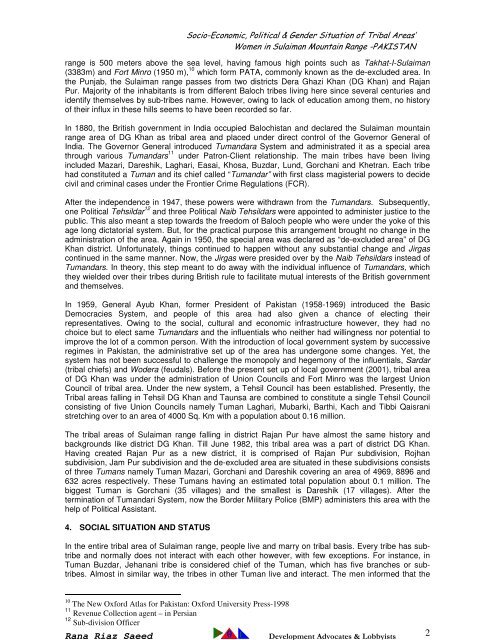Rana Riaz Saeed 1 - ResearchGate
Rana Riaz Saeed 1 - ResearchGate
Rana Riaz Saeed 1 - ResearchGate
Create successful ePaper yourself
Turn your PDF publications into a flip-book with our unique Google optimized e-Paper software.
Socio-Economic, Political & Gender Situation of Tribal Areas’<br />
Women in Sulaiman Mountain Range -PAKISTAN<br />
range is 500 meters above the sea level, having famous high points such as Takhat-I-Sulaiman<br />
(3383m) and Fort Minro (1950 m), 10 which form PATA, commonly known as the de-excluded area. In<br />
the Punjab, the Sulaiman range passes from two districts Dera Ghazi Khan (DG Khan) and Rajan<br />
Pur. Majority of the inhabitants is from different Baloch tribes living here since several centuries and<br />
identify themselves by sub-tribes name. However, owing to lack of education among them, no history<br />
of their influx in these hills seems to have been recorded so far.<br />
In 1880, the British government in India occupied Balochistan and declared the Sulaiman mountain<br />
range area of DG Khan as tribal area and placed under direct control of the Governor General of<br />
India. The Governor General introduced Tumandara System and administrated it as a special area<br />
through various Tumandars 11 under Patron-Client relationship. The main tribes have been living<br />
included Mazari, Dareshik, Laghari, Easai, Khosa, Buzdar, Lund, Gorchani and Khetran. Each tribe<br />
had constituted a Tuman and its chief called “Tumandar” with first class magisterial powers to decide<br />
civil and criminal cases under the Frontier Crime Regulations (FCR).<br />
After the independence in 1947, these powers were withdrawn from the Tumandars. Subsequently,<br />
one Political Tehsildar 12 and three Political Naib Tehsildars were appointed to administer justice to the<br />
public. This also meant a step towards the freedom of Baloch people who were under the yoke of this<br />
age long dictatorial system. But, for the practical purpose this arrangement brought no change in the<br />
administration of the area. Again in 1950, the special area was declared as “de-excluded area” of DG<br />
Khan district. Unfortunately, things continued to happen without any substantial change and Jirgas<br />
continued in the same manner. Now, the Jirgas were presided over by the Naib Tehsildars instead of<br />
Tumandars. In theory, this step meant to do away with the individual influence of Tumandars, which<br />
they wielded over their tribes during British rule to facilitate mutual interests of the British government<br />
and themselves.<br />
In 1959, General Ayub Khan, former President of Pakistan (1958-1969) introduced the Basic<br />
Democracies System, and people of this area had also given a chance of electing their<br />
representatives. Owing to the social, cultural and economic infrastructure however, they had no<br />
choice but to elect same Tumandars and the influentials who neither had willingness nor potential to<br />
improve the lot of a common person. With the introduction of local government system by successive<br />
regimes in Pakistan, the administrative set up of the area has undergone some changes. Yet, the<br />
system has not been successful to challenge the monopoly and hegemony of the influentials, Sardar<br />
(tribal chiefs) and Wodera (feudals). Before the present set up of local government (2001), tribal area<br />
of DG Khan was under the administration of Union Councils and Fort Minro was the largest Union<br />
Council of tribal area. Under the new system, a Tehsil Council has been established. Presently, the<br />
Tribal areas falling in Tehsil DG Khan and Taunsa are combined to constitute a single Tehsil Council<br />
consisting of five Union Councils namely Tuman Laghari, Mubarki, Barthi, Kach and Tibbi Qaisrani<br />
stretching over to an area of 4000 Sq. Km with a population about 0.16 million.<br />
The tribal areas of Sulaiman range falling in district Rajan Pur have almost the same history and<br />
backgrounds like district DG Khan. Till June 1982, this tribal area was a part of district DG Khan.<br />
Having created Rajan Pur as a new district, it is comprised of Rajan Pur subdivision, Rojhan<br />
subdivision, Jam Pur subdivision and the de-excluded area are situated in these subdivisions consists<br />
of three Tumans namely Tuman Mazari, Gorchani and Dareshik covering an area of 4969, 8896 and<br />
632 acres respectively. These Tumans having an estimated total population about 0.1 million. The<br />
biggest Tuman is Gorchani (35 villages) and the smallest is Dareshik (17 villages). After the<br />
termination of Tumandari System, now the Border Military Police (BMP) administers this area with the<br />
help of Political Assistant.<br />
4. SOCIAL SITUATION AND STATUS<br />
In the entire tribal area of Sulaiman range, people live and marry on tribal basis. Every tribe has subtribe<br />
and normally does not interact with each other however, with few exceptions. For instance, in<br />
Tuman Buzdar, Jehanani tribe is considered chief of the Tuman, which has five branches or subtribes.<br />
Almost in similar way, the tribes in other Tuman live and interact. The men informed that the<br />
10 The New Oxford Atlas for Pakistan: Oxford University Press-1998<br />
11 Revenue Collection agent – in Persian<br />
12 Sub-division Officer<br />
<strong>Rana</strong> <strong>Riaz</strong> <strong>Saeed</strong> Development Advocates & Lobbyists 2
















